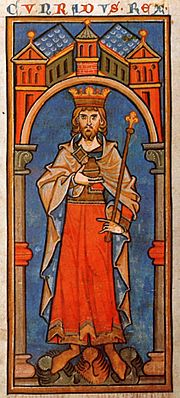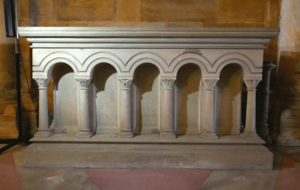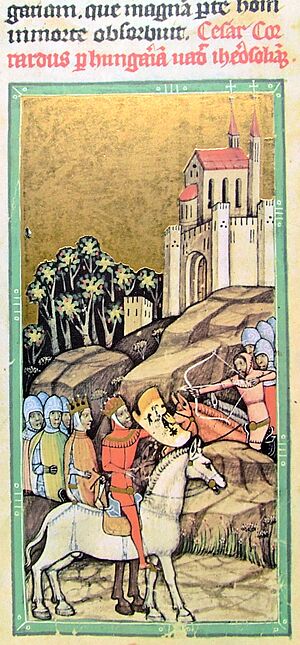Conrad III of Germany facts for kids
Quick facts for kids Conrad III |
|
|---|---|

King Conrad III (Cunradus rex) in a miniature from the Chronica sancti Pantaleonis, c. 1240
|
|
| King of Germany (formally King of the Romans) |
|
| Reign | 7 March 1138 – 15 February 1152 |
| Coronation | 13 March 1138, Aachen |
| Predecessor | Lothair III |
| Successor | Frederick I |
| King of Italy | |
| Reign | 1128–1135 |
| Coronation | 29 June 1128, Milan |
| Predecessor | Henry V |
| Successor | Frederick I |
| Born | 1093 or 1094 |
| Died | 15 February 1152 (aged 59-60) Bamberg, Bavaria |
| Burial | Bamberg Cathedral |
| Spouse |
|
| Issue |
|
| House | Hohenstaufen |
| Father | Frederick I, Duke of Swabia |
| Mother | Agnes of Germany |
| Religion | Roman Catholicism |
Conrad III (born 1093 or 1094 – died 15 February 1152) was an important ruler from the Hohenstaufen family. He was the Duke of Franconia from 1116 to 1120. Later, he became an anti-king against his predecessor, Lothair III, from 1127 to 1135. From 1138 until his death in 1152, he was the King of the Romans in the Holy Roman Empire.
Conrad was the son of Duke Frederick I of Swabia and Agnes. Agnes was the daughter of Emperor Henry IV from the Salian family. During his rule, the famous conflicts between the Guelphs and Ghibellines began. He also took part in the Second Crusade, which did not go well. He got sick and faced defeats. When he returned, he had more conflicts, especially with Welf VI. Before he died, he chose his nephew, Frederick Barbarossa, to be the next king instead of his own son.
Contents
Conrad's Family History
Conrad's family, the Hohenstaufens, came from the Duchy of Swabia. Their name came from Hohenstaufen Castle, built in 1105. Conrad's great-grandfather, Frederick of Staufen, was a count.
Conrad's father, Frederick of Hohenstaufen, was loyal to King Henry IV. Because of this, Henry IV made him Duke of Swabia in 1079. He also arranged for Frederick to marry his daughter, Agnes. Frederick died in 1105, leaving two sons: Conrad and his older brother, Frederick II. Frederick II inherited the title of Duke of Swabia. Their mother, Agnes, later married Leopold III, Margrave of Austria.
Conrad's Journey to Power
In 1105, Conrad's uncle, Henry V, became the new Holy Roman Emperor. In 1116, Henry V made Conrad the Duke of Franconia. Conrad and his brother, Frederick II, were chosen to rule Germany while the Emperor was away.
When Emperor Henry V died in 1125, Conrad supported his brother Frederick II to become the next king. However, Frederick was not chosen. Instead, Lothair became king. Conrad was then stripped of his lands.
With support from cities and regions like Swabia, Conrad was elected as an anti-king in December 1127. He quickly went to Italy and was crowned King of Italy in Milan. However, he didn't achieve much there. He returned to Germany in 1130. By 1135, Conrad and his brother had to accept Lothair as the true emperor. They were forgiven and got their lands back.
After Lothair died in December 1137, Conrad was elected king at Coblenz on March 7, 1138. He was crowned in Aachen six days later. Henry the Proud, who was Lothair's son-in-law and a very powerful prince, refused to accept Conrad as king. So, Conrad took away Henry's lands. This started a civil war. This war is seen as the beginning of the fight between the Guelphs and Ghibellines families.
After Henry the Proud died in 1139, his son Henry the Lion and brother Welf VI continued the war. Conrad defeated Welf VI at Weinsberg in 1140. A peace agreement was made in Frankfurt in 1142.
The Second Crusade
In 1146, Conrad heard Bernard of Clairvaux speak about the Second Crusade at Speyer. He decided to join Louis VII on a big journey to the Holy Land. Before leaving, Conrad made sure his son, Henry Berengar, was elected king. This was to secure the succession if Conrad died during the crusade.
Conrad's army of 20,000 men traveled by land through Hungary. They arrived in Constantinople in September 1147. Instead of taking the safer coastal road, Conrad led his army across Anatolia. On October 25, 1147, his army was defeated by the Seljuk Turks at the Battle of Dorylaeum. Conrad and most of his knights escaped, but many foot soldiers were killed.
Conrad became very ill in Ephesus and went to Constantinople to recover. The Byzantine Emperor Manuel I Comnenus even helped take care of him. After getting better, Conrad sailed to Acre and then reached Jerusalem. He took part in the failed Siege of Damascus. After this failure, he became unhappy with his allies. Another attempt to attack Ascalon also failed. Conrad then returned to Germany. On his way back, he met Emperor Manuel I again to discuss their alliance.
Later Years and Succession
In 1150, Conrad and his son Henry Berengar defeated Welf VI and his son Welf VII at the Battle of Flochberg. Sadly, Henry Berengar died later that year. This meant the question of who would be the next king was open again. The Welf and Hohenstaufen families made peace in 1152. This helped ensure a peaceful transfer of power within Conrad's family.
Conrad was never crowned emperor. He continued to be called "King of the Romans" until his death. On his deathbed, with only two witnesses, he reportedly chose his nephew, Frederick Barbarossa, to be his successor. This was instead of his own young son, Frederick, who was only six years old. Frederick Barbarossa, who had been with Conrad on the crusade, was elected king a few weeks later. Conrad's young son was given the Duchy of Swabia.

Conrad had no sons with his first wife, Gertrude von Komburg. In 1136, he married Gertrude of Sulzbach. Her sister, Bertha, was married to the Byzantine Emperor Manuel I. Gertrude was the mother of Conrad's children and helped strengthen his alliance with the Byzantine Empire.
See also
 In Spanish: Conrado III para niños
In Spanish: Conrado III para niños
- Kings of Germany family tree
Sources
- Baldwin, M. W. A History of the Crusades: the first hundred years, 1969.
- Bernhardi, Wilhelm (1883). Konrad III: Jahrbücher der Deutschen Geschichte. Leipzig: Duncker & Humblot.
- Magdalino, Paul (2004). "The Byzantine Empire (1118–1204)". In Luscombe, David; Riley-Smith, Jonathan. The New Cambridge Medieval History, Volume 4, c.1024–c.1198, Part 1. Cambridge: Cambridge University Press. pp. 611–643. ISBN 9781139054027. https://doi.org/10.1017/CHOL9780521414111.024.
- Ziegler, W. König Konrad III. (1138–1152). Hof, Urkunden und Politik (= Forschungen zur Kaiser- und Papstgeschichte des Mittelalters. Band 26) Böhlau, Wien u. a. 2008
|
Conrad III of Germany
House of Hohenstaufen
Born: 1093 Died: 1152 |
||
| Regnal titles | ||
|---|---|---|
| Preceded by Henry V |
King of Italy 1128–1135 |
Succeeded by Frederick I |
| Preceded by Lothair III |
German King (formally King of the Romans) (with Henry Berengar (1147–1150) 1138–1152 |
|


